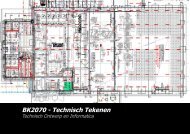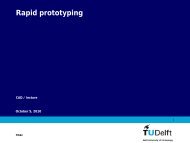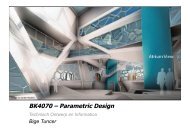Information andCommunicationTechnologyInformationTechnologyCommunicationTechnologyTo process <strong>in</strong>formation andmodel/elicit the knowledgeTo communicate <strong>in</strong>formationand knowledge between partiesFigure 1: Two different doma<strong>in</strong>s with<strong>in</strong> Information and Communication TechnologyIn that respect, this work is primarily related to Information Technology and with development ofadditional tools may become a part of Communication Technology as well. However, this willnot be the scope of this research. Hav<strong>in</strong>g placed the research with<strong>in</strong> a broader scope, thefollow<strong>in</strong>g step is to focus on the research problems themselves. In that context, it is necessary tostate difficulties regard<strong>in</strong>g architectural data, and to explore the possibility of employ<strong>in</strong>gInformation Technology for deal<strong>in</strong>g <strong>in</strong> particular with qualitative issues of underground spaces.2.4. Architectural design data and a role of ICT <strong>in</strong> designAn architectural design <strong>in</strong>volves a number of activities and considerations due to broad scope ofknowledge that is necessary from different experts. In that respect, the ICT tools can have animportant role <strong>in</strong> architectural design process. The essence of architectural design is that it hasmany l<strong>in</strong>guistic qualities, as well as the eng<strong>in</strong>eer<strong>in</strong>g components. Similar statements are given byLawson (1990) who states that architecture <strong>in</strong>volves elements that may seem both precise andnebulous, systematic and chaotic, mathematical and imag<strong>in</strong>ative. Architecture is a mixture of artand technique (Sariyildiz, 1991). This implies that the architect deals with not only eng<strong>in</strong>eer<strong>in</strong>gaspects that can be easily quantified and processed, but also deals with aesthetic issues that arequalitative and therefore difficult to estimate and represent numerically.In architectural design process, one has to establish certa<strong>in</strong> relations among the design<strong>in</strong>formation <strong>in</strong> advance, to make design with a sound rationale. The ma<strong>in</strong> difficulty at this po<strong>in</strong>t isthat such relationships may not be determ<strong>in</strong>ed because of various reasons. One example may bethe vagueness of the architectural design data due to their l<strong>in</strong>guistic qualities. In such cases, these'qualitative quantities' are expressed <strong>in</strong> l<strong>in</strong>guistic terms, which should somehow be expressed <strong>in</strong>numerical form, <strong>in</strong> order to treat such soft data by powerful and conclusive numerical analysismethods (Durmisevic, et. al., 2001a). Another example may be the vaguely def<strong>in</strong>ed designqualities, which should be gradually fixed dur<strong>in</strong>g the actual implementation, <strong>in</strong> order to ma<strong>in</strong>ta<strong>in</strong>the flexibility of the design for architectural, real-time decision-mak<strong>in</strong>g. To deal with suchflexible design <strong>in</strong>formation is not an easy task s<strong>in</strong>ce the majority of the exist<strong>in</strong>g architecturaldesign aids, so-called decision support systems, are based on the provision of concrete design<strong>in</strong>put <strong>in</strong>formation, and well-def<strong>in</strong>ed goals. Here the problem is not only the <strong>in</strong>itial fuzz<strong>in</strong>ess of- 14 -
the <strong>in</strong>formation but also the desired relevancy among all the pieces of <strong>in</strong>formation given.Presently, to determ<strong>in</strong>e the existence of such a relevancy is more or less a matter of architecturalsubjective judgement, rather than a systematic non-subjective decision-mak<strong>in</strong>g based on exist<strong>in</strong>gdesign <strong>in</strong>formation. In this respect, the <strong>in</strong>vocation of certa<strong>in</strong> design tools deal<strong>in</strong>g with such fuzzy<strong>in</strong>formation is essential for enhanced design decisions.Accord<strong>in</strong>g to Sariyildiz (2001), the ICT applications <strong>in</strong> the build<strong>in</strong>g sector can be categorized as atool, medium and <strong>in</strong> the near future, a partner. In the design environment, computers were firstput <strong>in</strong>to a practice as a tool or an <strong>in</strong>strument used to produce draw<strong>in</strong>gs or represent ideas throughanimation and simulation of virtual environments. As a tool they were ma<strong>in</strong>ly used for 3Dmodel<strong>in</strong>g, Computer Aided Draft<strong>in</strong>g as a replacement of a draw<strong>in</strong>g table, presentations, etc.Dur<strong>in</strong>g the last decade, computers have taken another role as a medium, ma<strong>in</strong>ly due to thewidespread use of the Internet and the development of the Web (Schmitt 1996). This stimulatedcommunication between different parties but the task assigned to computers has more or lessrema<strong>in</strong>ed the same. As a medium they are used for communication, <strong>in</strong>teractive visualization(such as virtual reality and cyber-space), collaborative and concurrent eng<strong>in</strong>eer<strong>in</strong>g, cooperativeeng<strong>in</strong>eer<strong>in</strong>g, CSCW (Computer Supported Collaborative Work), CAD-CAM (Computer AidedDesign Manufactur<strong>in</strong>g), CAE (Computer Aided Eng<strong>in</strong>eer<strong>in</strong>g), EEM (Enterprise Eng<strong>in</strong>eer<strong>in</strong>gManagement), etc.In the very near future, yet another shift can be expected when it comes to the computer's role <strong>in</strong>the design and build<strong>in</strong>g process as a partner (Schmitt, 1999). With present advances of ICT,especially the latest developments of Artificial Intelligence and knowledge technology,<strong>in</strong>creas<strong>in</strong>gly computers will take the role of partner. As a partner they can be used for knowledge<strong>in</strong>tegration and advanced model<strong>in</strong>g (with employment of ANN-Artificial Neural Networks, fuzzylogic, <strong>in</strong>telligent agents, genetic algorithms, grammars, etc.), IDSS (Intelligent Decision SupportSystems), <strong>in</strong>telligent management, etc.This research belongs to the category of apply<strong>in</strong>g ICT as a partner. In the near future, it can beexpected that such developments will become more common <strong>in</strong> the build<strong>in</strong>g sector.2.5. Architects and the end usersArchitectural design process is becom<strong>in</strong>g more complex, not only <strong>in</strong> its dimensionality and scopewith various partners <strong>in</strong>volved but also <strong>in</strong> the related <strong>in</strong>frastructure and communication. Inbuild<strong>in</strong>g processes, various partners are <strong>in</strong>volved, such as governmental <strong>in</strong>stitutions, urbanplanners, architects, constructors, technical advisors and users where each one of them has certa<strong>in</strong>requirements or knowledge expertise. Among all partners <strong>in</strong>volved, the communication with theusers is the least proficient. The distance between a designer and an end user became greater overtime. This is not so difficult to understand, s<strong>in</strong>ce there is a greater number of build<strong>in</strong>gs designedfor more end-users than ever before, for example, huge apartment complexes, hospitals, theaters,stations and mobility hubs. The complexity of build<strong>in</strong>g <strong>in</strong>creases and the related build<strong>in</strong>g<strong>in</strong>formation exponentially grows. In that respect, it is difficult for an architect to consider theneeds of end users s<strong>in</strong>ce the contact with the end user is almost nil. Still, this fact should not bejustification of the 'negligence' of user aspects dur<strong>in</strong>g design process. In a sense the approachlacks a systematic nature and is highly subjective. It is possible to expand the knowledge on user- 15 -
- Page 5: ContentsChapter 1 Introduction 11.1
- Page 9 and 10: CHAPTER 1Introduction1.1. Backgroun
- Page 11 and 12: In the Netherlands, most publicly u
- Page 13 and 14: spaces. There are also other aspect
- Page 15 and 16: The information to be processed is
- Page 17 and 18: CHAPTER 2From spatial planing to pe
- Page 19 and 20: In short, utilizing underground spa
- Page 21: Up until now it has been shown that
- Page 25 and 26: Another important conclusion is rel
- Page 27 and 28: develop a generic method to model t
- Page 29 and 30: In order to define the working area
- Page 31 and 32: spatialenvironmenthuman beingmental
- Page 33 and 34: CHAPTER 3Identification of the mode
- Page 35 and 36: case of emergency. Interestingly, t
- Page 37 and 38: judgement and experience of space.
- Page 39 and 40: Figure 4: View over the platform. U
- Page 41 and 42: •= Layout including both spatial
- Page 43 and 44: comfort seems to fulfill a biologic
- Page 45 and 46: Spatial CharacteristicsSpatial char
- Page 47 and 48: material/coloroverviewconstructione
- Page 49 and 50: Another aspect is the transparency
- Page 51 and 52: there are three key issues that are
- Page 53 and 54: •= the questions were closed, whi
- Page 55 and 56: CHAPTER 4Theoretical background on
- Page 57 and 58: some way or other has "memory". Add
- Page 59 and 60: XoWEIGHTSArtificial NeuronX1X2 Wj2.
- Page 61 and 62: Xthe inputspace(domain)inputsoutput
- Page 63 and 64: the text. This implies that general
- Page 65 and 66: numerical values. A variable is cal
- Page 67 and 68: artificial neural networks versus f
- Page 69 and 70: Figure 11: The inverse quadratic fu
- Page 71 and 72: part of the data as receptive field
- Page 73 and 74:
The main feature of expert systems
- Page 75 and 76:
• Use logical (deductive) reasoni
- Page 77 and 78:
CHAPTER 5Experimental research: Cas
- Page 79 and 80:
Figure 2: The old and new situation
- Page 81 and 82:
Figure 8, 9: Entrance to platform (
- Page 83 and 84:
Beurs/Churchillplein station is sit
- Page 85 and 86:
Figure 22, 23: The main entrance to
- Page 87 and 88:
Table 2: Aspects related to comfort
- Page 89 and 90:
5.3.3. ResponseFrom 27 May until 30
- Page 91 and 92:
7060605050404030302020Percentage100
- Page 93 and 94:
5.4.5. Way of orientingIn Figures 4
- Page 95 and 96:
Table 7: Perception of comfort in t
- Page 97 and 98:
CHAPTER 6Experimental research by k
- Page 99 and 100:
of input information i.e., the case
- Page 101 and 102:
Figure 3: Training results for rang
- Page 103 and 104:
Experiment 2aThe first 28 parameter
- Page 105 and 106:
formed by this knowledge model. In
- Page 107 and 108:
Table 4: Hierarchical order of sens
- Page 109 and 110:
Table 8: Hierarchical order of sens
- Page 111 and 112:
information structured as a knowled
- Page 113 and 114:
elationship it is understood to be
- Page 115 and 116:
10.80.60.40.201 4 7 10 13 16 19 22
- Page 117 and 118:
wilhelmina11.624.164.3wilhelmina36.
- Page 119 and 120:
wilhelmina6.720.373rijswijkblaak22.
- Page 121 and 122:
This study considered both metro an
- Page 123 and 124:
Some specific conclusions can be ma
- Page 125 and 126:
wilhelminarijswijkblaakbeurs9.62.59
- Page 127 and 128:
CHAPTER 7Conclusions and recommenda
- Page 129 and 130:
Furthermore, this research is also
- Page 131 and 132:
Additional efforts to improve knowl
- Page 133 and 134:
integrated computational intelligen
- Page 135 and 136:
Appendix A: Questionnaire for Blaak
- Page 137 and 138:
DEEL 3:HET VINDEN VAN DE WEGVraag 1
- Page 139 and 140:
DEEL 8:VERLICHTINGVraag 26: In hoev
- Page 141 and 142:
Appendix B : Learning based data an
- Page 143 and 144:
For further explanation regarding s
- Page 145 and 146:
ReferencesAlsop Architects (2001).
- Page 147 and 148:
COB (2000). Jaarverslag 1999. Centr
- Page 149 and 150:
Leonard J.A., Kramer M.A., and Unga
- Page 151 and 152:
Van Wegen, H. B. R. and Van der Voo
- Page 153 and 154:
SummaryThe intensification, combina
- Page 155 and 156:
aspects, which is derivation of dep
- Page 157 and 158:
SamenvattingBelevingsaspecten van O
- Page 159 and 160:
krachtige combinatie te zijn voor h
- Page 161 and 162:
AcknowledgmentsAfter formal discuss
- Page 163 and 164:
About the authorSanja Durmisevic wa
- Page 165 and 166:
BibliographyJournal publicationsDur
- Page 167:
Ciftcioglu Ö., Durmisevic S. and S





